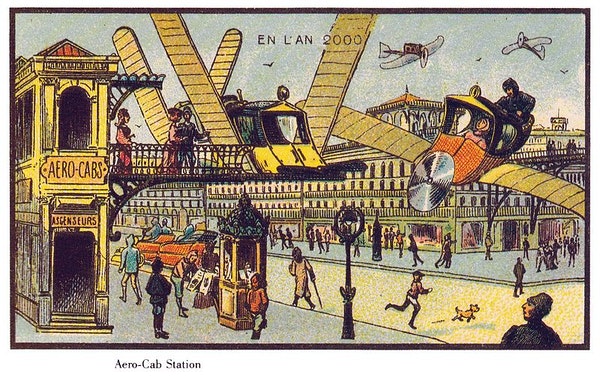What Goes Right and Wrong When We Predict a High-Tech Future
A pundit who predicted the internet also thought that the horse would be nearly extinct by nowAn article in Ladies’ Home Journal predicted 2001 a century earlier. Here’s a video version:
Futurism is a hit and miss business: Fast food is predicted (3:40) but so is the extinction of the horse (3:20). Apparently, the futurist, John Elfreth Watkins, Jr., did not foresee a future for horses in recreation and sports except for “the rich.”
He predicted the internet and wireless communications in principle (5:57, 13:29): “A husband sitting in the middle of the Atlantic will be able to converse with his wife sitting in her boudoir in Chicago.” But, surprisingly, he did not see much of a commercial future for the airplane but rather favored dirigibles and electrified ships (8:20ff).
He predicted high-speed trains but also electric sleighs for kids (17:16) Hmm. Did he not pause to think about concussion? No surprise, that idea never took off.
When predicting the future, we all may tend to either underestimate the advances:
The average American “will live fifty years, as opposed to thirty-five”
US life expectancy was about 78.6 years in 2017, principally due to clean water, healthier living conditions, and emergency medicine.
Or else we overestimate them:
“The trip to suburban home to office will require only a few minutes… a penny will pay the fare …” Dreamin’…
Commenters at YouTube offer some thoughts about what the 1901 futurist got right and wrong:
“‘giant guns will fire 25 miles or more’ Paris gun 13 years later could fire 81 miles.”
“The whole ‘we’ll get rid of all the annoying flying bugs’- thing showed that we clearly hadn’t quite figured out the whole ‘everything is connected’ aspect of the biosphere.”
and
“He predicted spy satellites in space before man had sent anything into space, granted he said they’d be balloons with cameras attached but they describe satellites”
Some predictions from a century ago from other sources
2010 looks back on a 1909 prediction, in this case by Nicola Tesla (1856–1943) in Popular Mechanics:
He wrote in the magazine that, one day it would be possible to transmit wireless messages all over the world.
Tesla, who spent most of his adult life in America before his death in New York in 1943, imagined such a hand-held device would be simple to use and that, one day, everyone in the world would communicate to friends using it.
This, he added, would usher in a new era of technology.
Andrew Hough, “Blackberry ‘predicted a century ago’ by pioneering physicist Nikola Tesla” at The Telegraph
Imagine. A handheld device…
2014 looks back on (roughly) 1914’s predictions via French vintage postcards popular during the 1900 World’s Fair and following:
One thing you see in the cards is a tendency to assume some things won’t change, even though they undoubtedly will. In one image, a couple flags down an aerotaxi. That’s futuristic enough, but the man is wearing spats and carrying a cane, while she has a parasol and an enormous hat with a feather. Did they really think transportation would undergo a revolution while fashion stayed frozen in time? “In every one of these you see a mix of a futuristic concept with stuff that looks to us to be very old fashioned,” [collector Ed] Fries said.
At the same time, there’s virtually no hint in the postcards of the truly transformative technologies of the last century–namely personal computers and the internet.
Greg Miller, “Here’s How People 100 Years Ago Thought We’d Be Living Today” at Wired
Here’s one card (public domain) depicting an “aerocab” station as seen from 1900:

Some of the jealously guarded cards are shown in this YouTube video.
and
2018 looks back on 1918’s predictions:
On January 6, 1918, the headline of an article in The Washington Times announced that the “Automobile of Tomorrow Will Be Constructed Like a Moving Drawing Room.” The author was writing about a prediction in Scientific American that described the car of the future. It would be water-tight and weather-proof, with sides made entirely of glass, and seats that could be moved anywhere in the vehicle. It would be decked out with power steering, brakes, heating, and a small control board for navigation. A finger lever would replace the steering wheel. Other designs imagined that cars would roll around on just three wheels, or on air-filled spheres to remove the need for shocks.
Claudia Geib, “Does Life In 2018 Live up to What We Predicted a Century Ago?” at Futurism
So much is right; again, the parts that the futurist gets wrong likely stem from not envisioning practical issues like the increased hazard from smashed glass during a minor collision.
The big disadvantage of making predictions for a century hence is that we probably won’t get to find out if they come true.
If you enjoyed this piece, you may also want to look at:
Truth is not only stranger than fiction, it sometimes grows out of it. A senior editor at Wired told us a while back that science fiction writer H. G. Wells’s 1914 tale, The World Set Free, formed part of the inspiration for the atomic bomb, exploded over Hiroshima in 1945.
and
Brilliant vision from a century ago foretells today’s internet. In E. M. Forster’s dystopia, people interact only through the Machine.
